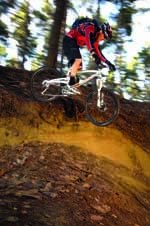 FRAME
FRAME
Even though the Marin has the shortest front end on test the slack seat angle and 100mm stem stretch the cockpit out to good proportions. Just don’t be tempted to run the saddle back on the seatpost for extra stretch, because combined with the short chainstay it’ll make it more difficult to keep the front end down while climbing seated. The new frame has a taller head tube but, as the bottom bracket is high, everything balances out nicely.
Marin uses modular dropouts on the Mount Vision swingarm so your bike is effectively future-proofed against changing disc mount or rear hub standards. More importantly, Marin could use this modular approach to offer size-specific dropouts without the cost associated with manufacturing four or five different swingarms.
Other nice touches are that all of the cable outer is held well clear of the fork crown and Marin uses smaller, gear-specific cable clips to stop the gear outer migrating as the suspension compresses.
SUSPENSION
Due to the tight configuration of Marin’s Quad XC Linkage design it’s pretty fiddly to get the suspension set up initially. Attaching a stock shock pump to the Fox RP23 shock is awkward and because Marin uses a high initial leverage ratio, it is easy to run the suspension too soft, as 25 per cent of shock travel equates to almost 50 per cent of the available wheel travel. Basically, you need to run less shock sag than you’d imagine to get the correct amount of actual wheel travel in sag. This sag setting is also more critical on the Marin than any of the other bike here because if you run too much sag you’ll be sitting in the wrong portion of the axle path, causing the suspension to compress with every pedal turn.
With the correct sag set, selecting one of the three ProPedal settings on the RP23 shock is also fiddly. Fortunately, once you’ve chosen your preferred level of ProPedal, it’s very easy to reach the blue ProPedal lever and toggle the on/off settings.
WHEELS
At higher inflation pressures the wide-spaced, central knobs on the WTB Prowler MX tyres generate a considerable amount of high frequency vibration — resulting in buzz at all three contact points and noticeable drag. Overall, traction isn’t bad but the Prowler felt strange at lower speeds, possibly a combination of the widely spaced knobs and micro tread. In the end we swapped out the tyres on all of the bikes in this test to Maxxis Cross Marks — so that we could test the performance of the bikes, not the tyres.
PERFORMANCE
On flowing trails the handling of the Marin is as good as any. Steering response is predictable and the balanced riding position delivers even traction front and rear, making for confident cornering in loose conditions. Get the Mount Vision on terrain where the handling of the bike is challenged, though, and its weakness starts to show. The high bottom bracket is a double-edged sword that allows you to pedal through rough off-camber trails and climb ascents without scuffing a pedal, but mated with a short wheelbase the bike tends to pitch and squat more than the others. We ran our saddle lower than normal to compensate. Additionally, because the rear suspension is more sag-critical than the other bikes here, you can’t use the suspension setup to fine-tune the head angle and bottom bracket height. Basically, if you run the suspension too soft, you end up with a bouncy bike with dramatically reduced rear wheel traction because the pedal forces pull the wheel away from the ground.
VERDICT
The Mount Vision is very much a Marin. It pedals well, it is designed to last in UK conditions and it has predictable, balanced handling. In keeping with Marin tradition it also has a high bottom bracket that will allow you to pedal through anything. If that’s your bag, then the 2008 Marin Mount Vision certainly won’t disappoint. We just feel that the handling could be improved further by lowering the bottom bracket height by half an inch without running into pedal clearance problems.
MBR RATING: 8/10



